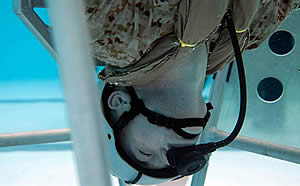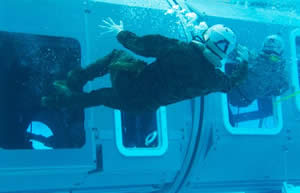
A Marine sits upside down in a shallow water egress trainer chair during Underwater Egress Training. Photo By: Lance Cpl. Richard Currier

Marines exit a Modular Amphibious Egress Trainer during Underwater Egress Training. Photo By: Lance Cpl. Richard Currier
As the fuselage filled up with water, Staff Sgt. Mikal A. Bowman braced himself and took one last breath just before the water covered his face.
"The first thing that was going through my mind was that I wanted it to be over," said Bowman, a warehouse chief for Combat Logistics Battalion 31, 31st Marine Expeditionary Unit. "It sucks doing it, but it helps you realize how serious it would be if you crashed into the ocean while inside of a [helicopter]. This training could help you save your life and other Marines' lives."
Marines with CLB-31 participated in Underwater Egress Training Dec. 9 at the Hansen Aquatics Center.
"Ditching, ditching, ditching!" yelled Blair H. Burton, an instructor, as he flips Bowman upside down in the shallow water egress trainer chair. After escaping the chair, Bowman advanced to escaping out of a simulated submerged aircraft that rolled over upon impact.
Completing UET certifies Bowman and the other Marines to be transported by helicopter over a body of water, a necessity for any 31st MEU Marine or sailor. To earn their certification, they were strapped into a Modular Amphibious Egress Trainer, flipped underwater and judged on how they escaped.
UET increases the chance of survival if an aircraft ditches into the water because it teaches the Marines to relax and use their evacuation skills.
There are several different simulated escapes students must complete. Instructors blindfold some of the students to simulate how it can be too dark underwater to see anything.
"It was tough, especially when you get blindfolded," said Bowman, a native of Washington, D.C. "It was definitely the hardest part for me, so hard that it took me three times to get it right. But you know how they say 'the third time is a charm.'"
Students learn through repetition, so the main steps get easier to remember: find the respirator, hold onto the seat, locate an exit, grip the exit, unbuckle the seatbelt, get out and swim to the surface while exhaling on the way up.
Burton and other instructors work hard to guide and encourage the students who are not comfortable in the water so that they can all successfully pass the course.
"You spend your entire life right-side up," said Burton, from Houston, Texas. "When we turn you upside down people seem to stop thinking straight and they don't know what to do. When they actually calm down and start thinking it shows that the training is sinking in and it's good to see that."
In the final scenario, Bowman was dunked underwater while blindfolded with a rifle and a flak jacket on. He safely pushed the rifle away, removed the flak jacket and moved across seats to find his exit.
"It wasn't pretty, but I got through it," said Bowman.
For some Marines, the course offers more than just a certification.
"From my experience, what I have noticed from Marines who have passed this course is that it boosts their confidence," said Burton. "It gives them the mentality to stay calm and to think rather than to panic and hurt themselves or others around them."
The Marines and sailors of CLB-31 are permanently assigned to the 31st MEU as the logistics combat element and are conducting pre-deployment preparations for the regularly-scheduled Spring Patrol of the Asia-Pacific region.
